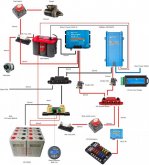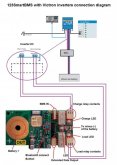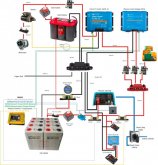Dear,
I have made up my mind about the system I would like to install on my boat. It consists of the following components:
Cells: 8* CALB 100Ah
BMS: 123SmartBMS or ??? (Something with low temperature disconnect)
Main switch: 2*701
Charger/ inverter: Victron Multiplus 24/1200 (incl. VE.Bus Smart Dongle)
Alternator: 60A
DC-DC charge controller: Victron Orion 12/24-15
Battery monitor: Victron BMV-712
DC-DC converter: Victron 24/12-20

At the moment I am not sure about using relays on the charge/ discharge on the batteries and which BMS to use.
I very much like the app from 123BMS but I am not the greatest fan of the PCB's that have to be mounted on the cells and the amp meters which can go faulty.
Furthermore, since I can still choose I am in doubt to change to a 24V system.
Would love to hear your comments.
Best regards, Dennis
I have made up my mind about the system I would like to install on my boat. It consists of the following components:
Cells: 8* CALB 100Ah
BMS: 123SmartBMS or ??? (Something with low temperature disconnect)
Main switch: 2*701
Charger/ inverter: Victron Multiplus 24/1200 (incl. VE.Bus Smart Dongle)
Alternator: 60A
DC-DC charge controller: Victron Orion 12/24-15
Battery monitor: Victron BMV-712
DC-DC converter: Victron 24/12-20

At the moment I am not sure about using relays on the charge/ discharge on the batteries and which BMS to use.
I very much like the app from 123BMS but I am not the greatest fan of the PCB's that have to be mounted on the cells and the amp meters which can go faulty.
Furthermore, since I can still choose I am in doubt to change to a 24V system.
Would love to hear your comments.
Best regards, Dennis
Last edited:





